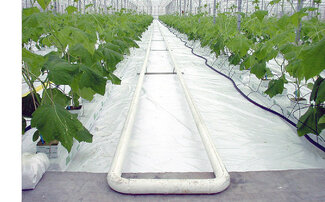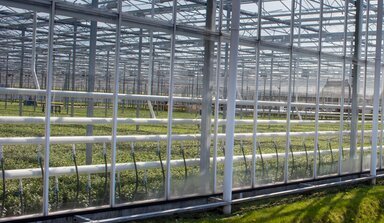Save energy by painting the pipes
Much is done in the modern greenhouse to save energy during the winter months. A saving that is simple to make, and one that is often forgotten, is painting the heating pipes.
 Due to mechanical wear and tear caused by the pipe rail trollies or rolling table systems, paint wears off the heating pipes leading to rust. These rusty pipes radiate 10 per cent less heat than a pipe that is evenly painted. Ten per cent is equivalent to a few degrees Celsius in the pipe. By painting the pipes the heat output is increased and the heating system is more cost effective. The return temperature drops so if a buffer and condenser are present they are better utilised. Also, the (speed regulator) heating pump can work less hard which saves energy.
Due to mechanical wear and tear caused by the pipe rail trollies or rolling table systems, paint wears off the heating pipes leading to rust. These rusty pipes radiate 10 per cent less heat than a pipe that is evenly painted. Ten per cent is equivalent to a few degrees Celsius in the pipe. By painting the pipes the heat output is increased and the heating system is more cost effective. The return temperature drops so if a buffer and condenser are present they are better utilised. Also, the (speed regulator) heating pump can work less hard which saves energy.
Two types of paint are available for painting the pipes. Paint containing a solvent and paint without. Solvent-based paints are fine to be applied in an empty greenhouse, for example by using an electrostatic robot. It is very important that the pipes are heated after the paint has been applied (to at least 80 degrees Celsius) to be sure that all the solvent evaporates out of the paint. These solvents are harmful to plants and will cause irrevocable damage.
When a solvent-free paint is used it isn’t necessary to heat the pipes. During both the application and drying of the paint it’s sufficient to keep the pipe temperature at about 30 degrees Celsius. The big advantage of a solvent-free paint is that it can be applied even if a crop is present in the greenhouse. As a result, you don’t lose time by applying the paint during the crop changeover. Always ensure that loose pieces of rust have been removed from the pipes before applying the paint. Solvent-free paint can be easily applied with a paint glove or roller.
Lumiforte has had a solvent free paint available for horticultural since 1997: PipePaint (previously ReduPaint). Before its launch, PipePaint was extensively tested by AB-DLO (now Wageningen UR) to check if any toxic fumes were released. Four sensitive crops (tomato, cucumber, kohlrabi and radish) were rigorously tested under the most unfavourable conditions possible. None of the crops showed any visible or physiological effects that could be attributed to the paint treatments.

